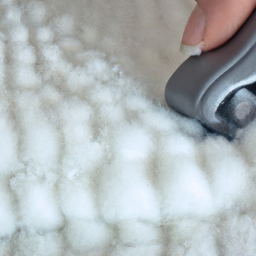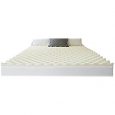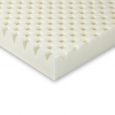
Taking care of your washable mattress topper is essential to ensure that it lasts as long as possible. By following a few simple care tips, you can prolong the lifespan of your mattress topper and keep it looking and feeling fresh. From regular cleaning to proper storage, these easy steps will help you maintain the quality and comfort of your mattress topper for years to come.
Regular Cleaning
Vacuuming
Regularly vacuuming your mattress topper is a simple yet effective way to keep it clean and free from debris. Use the brush attachment on your vacuum cleaner to gently remove dust, dirt, and allergens from the surface. Start from one corner and work your way across the entire topper, making sure to pay attention to any crevices or seams. Vacuuming at least once a month or more frequently if needed will help maintain a fresh and hygienic sleeping environment.
Spot Cleaning
Accidents happen, and when they do, it’s important to act quickly and address any spills or stains on your mattress topper. For small, localized stains, spot cleaning is the way to go. Start by blotting the stain with a clean, absorbent cloth or paper towel to soak up as much liquid as possible. Avoid rubbing the stain, as this can cause it to spread. Then, using a mild detergent mixed with water, gently dab the stained area. Rinse with clean water, blot dry, and allow the topper to air dry completely before using it again.
Machine Washing
Most mattress toppers are machine washable, making it convenient to keep them clean and fresh. Before tossing your topper into the washing machine, always check the care instructions provided by the manufacturer. Typically, you’ll want to use a gentle cycle and cold water. It’s best to wash your topper alone or with similar fabrics to prevent any damage. Once the wash cycle is complete, air dry the topper or use the lowest heat setting on your dryer, if applicable. Machine washing is recommended every few months or when the topper becomes visibly soiled.
Protective Measures
Using a Mattress Protector
Using a mattress protector is a proactive way to shield your mattress topper from spills, stains, and unwanted allergens. A mattress protector acts as a barrier, preventing liquids, dust mites, and other particles from seeping into the topper. It’s important to choose a protector that is waterproof and breathable to ensure maximum protection and comfort. Simply slip the protector over your mattress topper and secure it with the fitted elastic edges. Not only does a mattress protector extend the lifespan of your topper, but it also helps maintain a clean and hygienic sleeping environment.
Rotating the Mattress Topper
To ensure even wear and prolong the lifespan of your mattress topper, it’s recommended to rotate it regularly. This is particularly important for memory foam or latex toppers, as they can develop body impressions over time. By rotating the topper every few months, you distribute the weight and pressure exerted on it, preventing excessive sagging or indentations. To rotate the topper, simply remove it from your mattress, rotate it 180 degrees, and place it back on the bed. This simple step can help maintain the comfort and support of your topper for years to come.
Avoiding Spills and Stains
Prevention is always better than cure, and this holds true for your mattress topper as well. Avoiding spills and stains in the first place can help prolong its lifespan and keep it looking fresh. Be mindful when enjoying food or beverages on your bed, using a tray or table to minimize the risk of accidents. It’s also advisable to remove any sharp objects, such as pens or scissors, from the bed to prevent them from puncturing or tearing the topper. By taking these small precautions, you can keep your mattress topper in pristine condition for longer periods of time.
Drying and Air Circulation
Air Drying
When it comes to drying your mattress topper, air drying is the gentlest method. After spot cleaning or washing, allow the topper to air dry completely before using it again. Find a well-ventilated area away from direct sunlight and lay the topper flat on a clean surface or hang it on a clothesline. Make sure it is fully supported to avoid misshaping or sagging. Air drying helps to maintain the integrity of the materials, prevents shrinkage, and allows any residual moisture to evaporate naturally.
Avoiding Direct Sunlight
While sunlight exposure can have its benefits, it’s important to avoid direct sunlight when drying or storing your mattress topper. Prolonged exposure to sunlight can cause fading, discoloration, and deterioration of the materials. Instead, opt for shaded or indoor areas for drying your topper. If you need to remove any odors from the topper or freshen it up, limited exposure to sunlight for a short period can be beneficial. Always be cautious and avoid long-term exposure to prevent any damage to your mattress topper.
Using a Fan or Open Windows
Improving air circulation can aid in the drying process and prevent the growth of mold or mildew. If weather permits, open windows in the room to allow fresh air to circulate. A fan directed towards the topper can also help expedite the drying time. Moving air aids in evaporating moisture and keeps the topper fresh and dry. Remember to assess the weather conditions and humidity level before opting for this method, as excessive moisture in the air can impede the drying process.
Stain Removal
Act Quickly
When it comes to dealing with stains on your mattress topper, acting quickly is crucial. The longer a stain sits, the more challenging it becomes to remove. As soon as you notice a spill or stain, immediately blot the area with a clean cloth or paper towel to absorb as much liquid as possible. Avoid any vigorous rubbing motion, as this can push the stain deeper into the fabric or spread it to a larger area. By addressing stains promptly, you increase the chances of effectively removing them and preserving the appearance of your mattress topper.
Using Mild Cleaning Solutions
When it comes to cleaning your mattress topper, using mild cleaning solutions is key. Harsh chemicals can not only damage the topper’s fabric but also potentially degrade its overall quality. Opt for gentle, non-abrasive cleaning agents such as mild detergent or baby shampoo. Dilute the cleaning solution with water according to the manufacturer’s instructions or use a mixture of equal parts water and vinegar. Test the solution on an inconspicuous area of the topper before applying it to the stain to ensure it does not cause any discoloration or damage.
Avoiding Harsh Chemicals
While it can be tempting to turn to heavy-duty cleaners for tough stains, harsh chemicals should be avoided when dealing with mattress toppers. Bleach, ammonia, and other strong cleaning agents can break down the fibers of the topper and leave behind harmful residues. These chemicals can also emit strong odors and potentially cause skin irritation or respiratory issues. Stick to mild and natural cleaning solutions, or consult the care instructions provided by the manufacturer for any specific recommendations to ensure the longevity of your topper.
Removing Odors
Baking Soda
To tackle odors trapped in your mattress topper, baking soda is a reliable and natural solution. Sprinkle a generous amount of baking soda over the entire surface of the topper and let it sit for several hours or overnight. Baking soda works by absorbing and neutralizing unpleasant odors. After the recommended wait time, thoroughly vacuum the topper to remove the baking soda residue. Not only does this help eliminate odors, but it also freshens up the topper, leaving it smelling clean and inviting.
Vinegar Solution
Another effective odor-removing option is a vinegar solution. Mix equal parts white vinegar and water in a spray bottle. Lightly spray the solution over the entire surface of the topper, focusing on any areas with lingering odors. Vinegar acts as a natural deodorizer and can help break down the source of the smell. Allow the topper to air dry completely, preferably in a well-ventilated area. The vinegar odor will dissipate as the topper dries, leaving your mattress topper with a neutral scent.
Sunlight Exposure
Sunlight exposure can also work wonders in eliminating odors from your mattress topper. Choose a day with ample sunlight and lay the topper on a clean surface in a shaded area outdoors. Sunlight has natural antimicrobial properties that can help neutralize odors and kill bacteria. The fresh air and sunlight will aid in removing any trapped odors and give your topper a revitalizing boost. Remember to only expose the topper for a limited time, as extended exposure can lead to discoloration or damage.
Dealing with Allergens
Regular Washing
To address allergens and maintain a clean sleeping environment, regular washing of your mattress topper is essential. Dust mites, pollen, pet dander, and other allergens can accumulate over time, causing discomfort or allergies. Depending on the specific care instructions provided by the manufacturer, wash your topper every few months or when it becomes visibly dirty or odorous. This practice will effectively remove allergens, keeping your topper fresh and hygienic. Always refer to the care label and follow the recommended washing guidelines to avoid damaging the topper.
Hot Water and High Heat Drying
When washing your mattress topper, opt for hot water and high heat drying when applicable. Hot water helps kill dust mites and remove any allergens embedded in the fabric. The high heat setting on the dryer aids in effectively sanitizing the topper, ensuring it is free from microscopic irritants. However, always refer to the manufacturer’s guidelines, as some toppers may be sensitive to high heat and may require alternative methods of drying, such as air drying or low-heat settings.
Hypoallergenic Mattress Topper
If you suffer from allergies or sensitivities, investing in a hypoallergenic mattress topper can significantly alleviate symptoms. Hypoallergenic toppers are specifically designed to minimize allergen accumulation, making them an ideal choice for those with respiratory issues or sensitivities to dust mites. These toppers are typically made from materials that naturally repel allergens, such as latex or hypoallergenic fibers. When combined with regular washing and other protective measures, a hypoallergenic mattress topper can create a healthier sleep environment for you.
Handling Wear and Tear
Avoid Jumping on the Mattress Topper
While it may be tempting to use your mattress topper as a trampoline or subject it to rough play, it’s important to avoid jumping on it. Excessive pressure or impact can cause the topper’s materials to compress or become misshapen. Jumping on the topper can also exert unnecessary strain on the seams, leading to tears or damage. Treat your mattress topper with care and remind others to do the same to ensure its longevity and overall performance.
Trimming Loose Threads
Over time, loose threads may appear on your mattress topper, particularly at the seams or edges. It’s crucial to address these loose threads promptly to prevent them from unraveling further and potentially causing more significant damage. Simply trim the loose threads with a pair of scissors, taking care not to cut any surrounding fabric. Regularly inspect your topper for loose threads and address them as soon as they are noticed to maintain its appearance and structural integrity.
Using a Mattress Topper Cover
To provide an extra layer of protection against wear and tear, consider using a mattress topper cover. These covers are designed to fit snugly over your topper and protect it from daily wear, spills, and stains. A cover acts as a barrier, preventing direct contact with the topper and absorbing any impact or pressure. Additionally, a cover can be easily removed and washed, making it a convenient and effective way to maintain the condition of your mattress topper.
Storage Tips
Clean and Dry the Mattress Topper
Before storing your mattress topper, ensure it is thoroughly cleaned and completely dry. Any moisture or residue left on the topper can lead to the growth of mold or mildew during storage. Follow the appropriate cleaning methods outlined earlier and allow sufficient time for the topper to air dry, preferably in a well-ventilated area. Only proceed with storage once the topper is in a pristine and dry condition.
Avoid Compression
When it comes to storing your mattress topper, it’s crucial to avoid compressing it. Compressing a mattress topper for an extended period can result in permanent damage, such as deformation or loss of cushioning. To prevent compression, store the topper in a spacious area where it can lay flat or be rolled loosely, depending on its size and material. Avoid stacking heavy objects on top of the topper, as this can also cause compression and compromise its overall quality.
Using a Breathable Storage Bag
To protect your mattress topper from dust, pests, and excess moisture during storage, consider using a breathable storage bag. Opt for a bag made from a material that allows air circulation while still providing a protective barrier. This helps prevent the accumulation of dust, allergens, and potential mildew growth. Place the topper in the storage bag, ensuring there is enough room for it to expand and breathe. Store the bag in a cool, dry area, away from direct sunlight and extreme temperature fluctuations.
Prolonging Foam Toppers
Flipping and Rotating
If you have a foam mattress topper, regularly flipping and rotating it will help distribute the weight and ensure even compression. Memory foam and other foam materials can develop body impressions over time, which affect their support and comfort. By flipping the topper every few months and rotating it 180 degrees, you mitigate the risk of uneven wear and maintain the topper’s original feel. This simple practice extends the lifespan of foam toppers and ensures consistent comfort throughout their use.
Using a Mattress Protector
When it comes to foam toppers, using a mattress protector is particularly important. Foam materials are more sensitive to spills and liquids, which can seep into the topper and cause damage. Opt for a waterproof and breathable mattress protector specifically designed for foam mattresses or toppers. This protective layer acts as a barrier against moisture and prevents any potential stains or odors from permeating the foam. With a mattress protector in place, you can safeguard your foam topper and significantly extend its lifespan.
Proper Storage
Proper storage is crucial for foam toppers to maintain their shape and integrity. When not in use, store your foam topper in a clean, dry, and well-ventilated area. Avoid folding or compressing the topper, as this can cause permanent creases or deformities. Instead, lay the topper flat or roll it loosely, depending on the available space. Foam toppers can be sensitive to extreme temperatures, so it’s best to store them away from areas prone to excessive heat or cold. By following these storage practices, you can keep your foam topper in optimal condition for years of comfortable sleep.
Maintaining Feather Toppers
Fluffing and Shaking
Feather toppers require regular fluffing and shaking to maintain their loft and distribution of feathers. Every time you change your sheets or notice the topper becoming compressed, give it a good shake and fluff. This helps to redistribute the feathers and maintain a nice even fill. It’s also beneficial to give the topper a vigorous shake and fluff every couple of weeks to prevent the feathers from clumping together or flattening with prolonged use. By taking a few moments to fluff and shake your feather topper, you ensure a comfortable and luxurious sleep experience.
Sunlight Exposure
Natural sunlight can be your ally when it comes to maintaining a clean and fresh feather topper. Occasional exposure to sunlight helps to kill any bacteria or microbial growth that may be present in the feathers. Additionally, sunlight can help eliminate any residual odors trapped in the topper, leaving it smelling clean and rejuvenated. Lay your feather topper outside on a clean surface for a limited time, making sure to protect it from direct sunlight for extended periods to prevent discoloration or feather degradation.
Spot Cleaning
Accidents happen and can lead to stains on your feather topper. Spot cleaning is an effective way to address minor stains without compromising the topper’s overall condition. Start by gently blotting the stained area with a clean, absorbent cloth or paper towel to remove any excess liquid. Avoid rubbing the stain, as this can cause it to spread or push it deeper into the feathers. Use a mild upholstery or fabric cleaner specifically designed for feathers and follow the instructions on the cleaner’s packaging. After spot cleaning, allow the topper to air dry completely before using it again.
In conclusion, with proper care and maintenance, washable mattress toppers can provide you with years of comfort and support. By incorporating regular cleaning routines, using protective measures, ensuring proper drying, effectively removing stains and odors, addressing allergens, handling wear and tear, practicing proper storage, and employing specific care tips for foam and feather toppers, you can extend the lifespan of your mattress topper and enjoy a cleaner and healthier sleeping environment. So, follow these simple care tips and rest easy knowing that your mattress topper is well taken care of.



